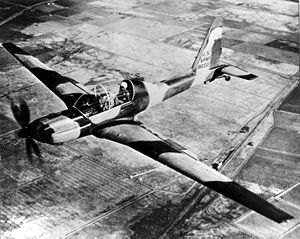Lockheed YO-3 Video - Overview
|
|
Lockheed YO-3
YO-3

Role: Reconnaissance--Night
Manufacturer: Lockheed Missiles and Space Corporation
First flight: 1969
Introduction: 1969
Primary user: United States Army
Number built: 11
Developed from: Schweizer SGS 2-32
The Lockheed YO-3 "Quiet Star" was an American single-engined, propeller-driven monoplane that was developed for battlefield observation during the Vietnam War. It was designed to be as quiet as possible, and was intended to observe troop movements in near-silence during hours of darkness.
Design and development
The YO-3A was designed to a U.S. Army specification of 1968, which called for an observation aircraft that would be acoustically undetectable from the ground when flying at an altitude of 1,200 feet at night. Lockheed was approached to produce such a design. In 1966 the company built a prototype QT1 "Quiet Thrust", AKA X-26B using a modified Schweizer SGS 2-32 glider. This was abandoned for two prototypes of a two-seat version called the QT-2 PRIZE CREW. The QT had a silenced engine and a propeller operating at subsonic tip speed for quiet operation.
Following operation trials with the QT-2 in Vietnam, 1968, a production version, designated the YO-3A was ordered by the Army. Based on the QT2's SGS 2-32 platform, the YO-3A was highly modified. It had a low-mounted wing, retractable main-wheel landing gear and a modified fuselage with tandem seating for a pilot in back and an observer in the front seat using a NVAP (Night Vision Aerial Periscope) and infrared illuminator. The YO-3A was powered by a 210 hp IO-360 engine driving a six-bladed fixed-pitch propeller; the propeller was later changed to a wooden three-bladed constant-speed version.
Nine of the eleven YO-3As in production by LMSC operated in South Vietnam, at night, 1970-71 (14 months) and never took a round or were shot down. The YO-3A was very successful in spotting movement by the North Vietnamese, but its deployment late in the American involvement in Vietnam reduced its value in that war. By 1975 all American troops were out of Vietnam.
Operational history
Vietnam War
Following combat evaluation of the QT-2s in Vietnam by the Army, nine production YO-3As were sent to Long Thanh North, Vietnam in 1970. three were sent to Phu Bai and two to Binh Thuy. The aircraft were used at night, at low altitudes. Observations were made visually (80%) and with followed on with a Night Vision Aerial Periscope developed by Xerox Electro-Optical, Pasadena California night vision devices. The YO-3A had a specially designed propeller operated by 12 belts, an exhaust system that ran the length of the aircraft and other sound quieting technologies. The mission equipment on the YO-3A was a Night Vision Aerial Periscope with infrared illuminator. One YO-3A was equipped with a laser target designator. The laser system was never used. The YO-3A operated silently at 1,000 feet, or lower, depending on terrestrial background noise. Some pilots were known to have gone unobserved over the enemy at 200 feet. Occasionally daylight flights were made over the rivers. Crew chiefs would listen to the YO-3A flying over the maintenance section prior to deployment listening for rattles, whistles or other noises. The propeller, even at 500 feet over the maintenance area made only a light flutter heard just as it approached the maintenance area. This was followed by a light rushing of wind over the wings. Once the plane had passed over, there was no audible sound. If any noises were heard, the plane returned to the runway and duct tape and other measures were taken to quiet noticeable sounds.
Post-war usage
After Vietnam, two YO-3As, 69-18006 and 69-18007, were used by the Louisiana Department of Fish and Game. The plane was effective at catching poachers. The FBI eventually acquired the aircraft, and operated the planes for several years, assisting the apprehension of kidnappers and extortionists.
NASA took possession of one YO-3A, 69-18010, in the late 1970s. The plane was used in rotorcraft research. Most recently, it was in operation at Moffett Field, California. (This aircraft was to be returned to NASA's Dryden research facility at Edwards AFB, California in early 2009.)
Variants
QT-1 Quiet Thrust
Prototype single-seat glider conversion
QT-2
Two-seat version, two built for combat evaluation
Q-Star
One-aircraft for propeller development
YO-3A
Production aircraft for the United States Army, 11 built
Operators
Military operators
United States
United States Army
Civil operators
United States
FBI
Louisiana Department of Fish and Game
NASA
Survivors
18000 is on display at the Army Collection at Fort Rucker.
18001 is on display at the Hiller Museum.
18005 is parked at Skagit Regional Airport, Washington.
18006 is at the Pima Air and Space Museum, Arizona.
18007 is at Cable Airport Upland California with the CAF 3rd Pursuit Squadron and is in the process of being restored to flight status.
18010 belongs to NASA and is still flying. Currently based at Moffett Federal Airfield, California.
Specifications
X-26 Frigate
John Andrade, U.S.Military Aircraft Designations and Serials since 1909, Midland Counties Publications, 1979, ISBN 0 904597 22 9 (Page 140)
The Illustrated Encyclopedia of Aircraft (Part Work 1982-1985), 1985, Orbis Publishing
Lockheed YO-3 Pictures and Lockheed YO-3 for Sale.
Living Warbirds: The best warbirds DVD series.
Source: WikiPedia